Performance Evaluation of Rapid Entire Body Assessment Using AI-Assisted Ergonomic Analysis in Dentistry
Abstract
:1. Introduction
2. Methodology of Assessment
2.1. Flow of Analysis
2.2. Conventional REBA
2.3. Automation of REBA by MediaPipe
2.3.1. Camera Arrangement
2.3.2. Function of MediaPipe
2.3.3. Accomplishment of Image Occlusion
2.3.4. Data Fusion
2.3.5. Response Surface Method
3. Results and Discussion
3.1. Superiority of Methodology
3.2. Performance Using MediaPipe Processing
3.3. Performance Based on RSM Analysis
3.4. Optimum Results from RSM Analysis
4. Summary and Conclusions
- The utilization of three cameras positioned around the dentist, along with the AI tool ‘MediaPipe,’ facilitates an accurate evaluation of REBA. Specifically, the use of three temporally synchronized videos mitigates errors caused by image/visual occlusion.
- With the help of time-synchronized videos of three cameras, the angle for each joint is averaged, which helps eliminate errors compared to actual observations.
- The evaluated REBA score using MediaPipe has been compared to the single-image-based conventional method and verified to be accurate within a relative error of approximately ±10%, as observed in Figure 14.
- From the results obtained from the study, 83% of dentists are categorized as high risk, while the remainder are classified as very high risk. Therefore, solutions need to be devised for all of them to reduce their REBA scores and avert MSD.
- The RSM model is significant, as evidenced by the R2 and p values shown in Table 6. From the outcomes, a linear regression equation has been obtained. The outcomes of RSM closely align with the observed REBA score, exhibiting a relative error of less than ±10% (Figure 14). Contour graphs linking the variables facilitate the analysis of the relative variation of REBA points.
- The optimized REBA score signifies the attainable maximum values for the 14 dentists, as indicated in Table 7 andFigure 17. While concentrating on one joint, the dentist may demonstrate an augmented angle in another joint. Therefore, the optimized profile can be utilized to establish a warning limit. The maximized and minimized profiles of REBA have been validated against the REBA evaluation chart and shown to be accurate.
- The minimized REBA score represents the optimal achievable answer that any dentist may aim for. The design paths for Dr#2 and Dr#5 are delineated in the reduced 2D contour of RSM. The minimized REBA profile functions as a design constraint.
Author Contributions
Funding
Institutional Review Board Statement
Informed Consent Statement
Data Availability Statement
Acknowledgments
Conflicts of Interest
Abbreviations
| MSD | Musculoskeletal disorder |
| DOE | Design of experiment |
| RSM | Response surface methodology |
| REBA | Rapid Entire Body Assessment |
| FLD | Face Landmark Detection |
| PLD | Pose Landmark Detection |
References
- Mito, R.S.; Fernandez, K. Why is ergonomics an issue in dentistry? J. Calif. Dent. Assoc. 2002, 30, 133–134. [Google Scholar] [CrossRef] [PubMed]
- Bernard, B.P.; Putz-Anderson, V. Musculoskeletal Disorders and Workplace Factors: A Critical Review of Epidemiologic Evidence for Work-Related Musculoskeletal Disorders of the Neck, Upper Extremity, and Low Back; National Institute for Occupational Safety and Health: Washington, DC, USA, 1997.
- Gerr, F.; Fethke, N.B.; Merlino, L.; Anton, D.; Rosecrance, J.; Jones, M.P.; Marcus, M.; Meyers, A.R. A prospective study of musculoskeletal outcomes among manufacturing workers: I. Effects of physical risk factors. Hum. Factors 2014, 56, 112–130. [Google Scholar] [CrossRef] [PubMed]
- Jin, L.; Ren, Q.; Mitchell, V.; May, A. A video processing and machine learning based method for evaluating safety-critical operator engagement in a motorway control room. Ergonomics 2024, 67, 356–376. [Google Scholar] [CrossRef]
- Yazdanirad, S.; Pourtaghi, G.; Raei, M.; Ghasemi, M. Development of modified rapid entire body assessment (MOREBA) method for predicting the risk of musculoskeletal disorders in the workplaces. BMC Musculoskelet. Disord. 2022, 23, 82. [Google Scholar] [CrossRef]
- Stock, S.R. Workplace ergonomic factors and the development of musculoskeletal disorders of the neck and upper limbs: A meta-analysis. Am. J. Ind. Med. 1991, 19, 87–107. [Google Scholar] [CrossRef]
- Das, B. An evaluation of low back pain among female brick field workers of West Bengal, India. Environ. Health Prev. Med. 2015, 20, 360–368. [Google Scholar] [CrossRef] [PubMed]
- Rafie, F.; Zamani Jam, A.; Shahravan, A.; Raoof, M.; Eskandarizadeh, A. Prevalence of upper extremity musculoskeletal disorders in dentists: Symptoms and risk factors. J. Environ. Public Health 2015, 2015, 517346. [Google Scholar] [CrossRef]
- ZakerJafari, H.R.; YektaKooshali, M.H. Work-related musculoskeletal disorders in Iranian dentists: A systematic review and meta-analysis. Saf. Health Work 2018, 9, 1–9. [Google Scholar] [CrossRef]
- Markova, V.; Markov, M.; Petrova, Z.; Filkova, S. Assessing the impact of prolonged sitting and poor posture on lower back pain: A photogrammetric and machine learning approach. Computers 2024, 13, 231. [Google Scholar] [CrossRef]
- Sardinha, L.; Baleiras, J.V.; Sousa, S.; Lima, T.M.; Gaspar, P.D. Decision Support System (DSS) for Improving Production Ergonomics in the Construction Sector. Processes 2024, 12, 2503. [Google Scholar] [CrossRef]
- Bhatia, V.; Randhawa, J.S.; Jain, A.; Grover, V. Comparative analysis of imaging and novel markerless approach for measurement of postural parameters in dental seating tasks. Meas. Control 2020, 53, 1059–1069. [Google Scholar] [CrossRef]
- Sachdeva, A.; Bhateja, S.; Arora, G. Ergonomics in dentistry: A comprehensive review. J. Dent. Res. Rev. 2020, 7, 32–35. [Google Scholar]
- MassirisFernández, M.; Fernández, J.Á.; Bajo, J.M.; Delrieux, C.A. Ergonomic risk assessment based on computer vision and machine learning. Comput. Ind. Eng. 2020, 149, 106816. [Google Scholar] [CrossRef]
- Ali, S.M.; Noghanian, S.; Khan, Z.U.; Alzahrani, S.; Alharbi, S.; Alhartomi, M.; Alsulami, R. Wearable and Flexible Sensor Devices: Recent Advances in Designs, Fabrication Methods, and Applications. Sensors 2025, 25, 1377. [Google Scholar] [CrossRef]
- Jeong, S.-o.; Kook, J. CREBAS: Computer-based REBA evaluation system for wood manufacturers using MediaPipe. Appl. Sci. 2023, 13, 938. [Google Scholar] [CrossRef]
- Kee, D. Comparison of OWAS, RULA and REBA for assessing potential work-related musculoskeletal disorders. Int. J. Ind. Ergon. 2021, 83, 103140. [Google Scholar] [CrossRef]
- Vaisbuch, Y.; Aaron, K.A.; Moore, J.M.; Vaughan, J.; Ma, Y.; Gupta, R.; Jackler, R.K. Ergonomic hazards in otolaryngology. Laryngoscope 2019, 129, 370–376. [Google Scholar] [CrossRef]
- Varmazyar, S.; Amini, M.; Kiafar, M. Ergonomic Evaluation of Work Conditions in Qazvin Dentists and Its Association with Musculoskeletal Disorders Using REBA Method; Islamic Dental Association of Iran: Tehran, Iran, 2012. [Google Scholar]
- Koushik Balaji, K.; Alphin, M. Computer-aided human factors analysis of the industrial vehicle driver cabin to improve occupational health. Int. J. Inj. Control Saf. Promot. 2016, 23, 240–248. [Google Scholar] [CrossRef]
- Fujishiro, K.; Weaver, J.L.; Heaney, C.A.; Hamrick, C.A.; Marras, W.S. The effect of ergonomic interventions in healthcare facilities on musculoskeletal disorders. Am. J. Ind. Med. 2005, 48, 338–347. [Google Scholar] [CrossRef]
- Lambrides, E.; Christodoulou, S. Human action detection and ergonomic risk assessment at construction sites, by use of machine vision and deep learning. In Proceedings of the EC3 Conference 2023, Crete, Greece, 10–12 July 2023; pp. 450–456. [Google Scholar]
- Hita-Gutiérrez, M.; Gómez-Galán, M.; Díaz-Pérez, M.; Callejón-Ferre, Á.J. An overview of REBA method applications in the world. Int. J. Environ. Res. Public Health 2020, 17, 2635. [Google Scholar] [CrossRef]
- Kuber, P.M.; Rashedi, E. Training and Familiarization with Industrial Exoskeletons: A Review of Considerations, Protocols, and Approaches for Effective Implementation. Biomimetics 2024, 9, 520. [Google Scholar] [CrossRef] [PubMed]
- Mistarihi, M.Z.; Al-Omari, A.A.; Al-Dwairi, A.F. Designing and Simulation Assessment of a Chair Attachment Air Blowing Methods to Enhance the Safety of Prolonged Sitting. Biomimetics 2023, 8, 194. [Google Scholar] [CrossRef]
- Hignett, S.; McAtamney, L. Rapid entire body assessment (REBA). Appl. Ergon. 2000, 31, 201–205. [Google Scholar] [CrossRef] [PubMed]
- López-Monzoni, S.; Hernando Benito, G.; Romero-Peralta, S.; Silgado-Martínez, L.; Viejo-Ayuso, M.E.; Álvarez-Balado, L.; Rodríguez Matarranz, E.; Forné Izquierdo, C.; Sánchez-de-la-Torre, M.; Masa, J.F. Improving Anxiety Related to Chronic Pain Through a Sleep Circadian Intervention Program: A Pilot Study. Behav. Sci. 2025, 15, 40. [Google Scholar] [CrossRef]
- Rios Andreghetti, G.; Montemurro, S.; Rizzi, L.; Casetta, L.; Passarelli, M.; Mondini, S.; Rocco, D. Psychological Features of Fibromyalgia in the Psychological Health Services. Behav. Sci. 2024, 14, 1016. [Google Scholar] [CrossRef]
- Sargano, A.B.; Vandenitte, S.; Jantunen, T.; Kimmelman, V. Evaluation of Head Pose Estimation Algorithms for Sign Language Analysis. In Proceedings of the 2024 International Conference on IT and Industrial Technologies (ICIT), Chiniot, Pakistan, 10–12 December 2024; pp. 1–6. [Google Scholar]
- Thierfelder, S. Head Pose Estimation with MediaPipe and OpenCV in Javascript. 2022. Available online: https://medium.com/@susanne.thierfelder/head-pose-estimation-with-mediapipe-and-opencv-in-javascript-c87980df3acb (accessed on 15 November 2022).
- Janapati, M.; Allamsetty, L.P.; Potluri, T.T.; Mogili, K.V. Gait-Driven Pose Tracking and Movement Captioning Using OpenCV and MediaPipe Machine Learning Framework. Eng. Proc. 2024, 82, 4. [Google Scholar] [CrossRef]
- Kim, J.; Park, B.y.; Mun, S.J.; Shim, J.; Choi, E.S.; Noh, H. Differences in plantar pressure by REBA scores in dental hygienists. Int. J. Dent. Hyg. 2019, 17, 177–182. [Google Scholar] [CrossRef]
- Kong, Y.-K.; Lee, S.-y.; Lee, K.-S.; Kim, D.-M. Comparisons of ergonomic evaluation tools (ALLA, RULA, REBA and OWAS) for farm work. Int. J. Occup. Saf. Ergon. 2018, 24, 218–223. [Google Scholar] [CrossRef] [PubMed]
- Kumar, A.; Indher, H.K.B.; Gul, A.; Nawazc, R. Analysis of Risk Factors for Work-related Musculoskeletal Disorders: A Survey Research. Int. J. Eng. Manuf. 2022, 12, 1. [Google Scholar] [CrossRef]
- Jahanimoghadam, F.; Hasheminejad, N.; Hashemi-Nejad, N. Body Posture Evaluation of Dental Specialty Groups and Risk of Developing Musculoskeletal Disorders. J. Dent. Indones. 2021, 28, 171–176. [Google Scholar]
- García, C.L.; Roa, A.; Pérez, A.; Losada, W.; Ortiz, C.P.; Delgado, D.R. Back and Neck Musculoskeletal Symptoms Associated with the Level of Postural Risk Experienced by Dentists. arXiv 2022. [Google Scholar] [CrossRef]
- Meisha, D.E.; Alsharqawi, N.S.; Samarah, A.A.; Al-Ghamdi, M.Y. Prevalence of work-related musculoskeletal disorders and ergonomic practice among dentists in Jeddah, Saudi Arabia. Clin. Cosmet. Investig. Dent. 2019, 5, 171–179. [Google Scholar] [CrossRef] [PubMed]
- Statham, M.M.; Sukits, A.L.; Redfern, M.S.; Smith, L.J.; Sok, J.C.; Rosen, C.A. Ergonomic analysis of microlaryngoscopy. Laryngoscope 2010, 120, 297–305. [Google Scholar] [CrossRef] [PubMed]
- Sweeney, K.; Mackey, M.; Spurway, J.; Clarke, J.; Ginn, K. The effectiveness of ergonomics interventions in reducing upper limb work-related musculoskeletal pain and dysfunction in sonographers, surgeons and dentists: A systematic review. Ergonomics 2021, 64, 1–38. [Google Scholar] [CrossRef]
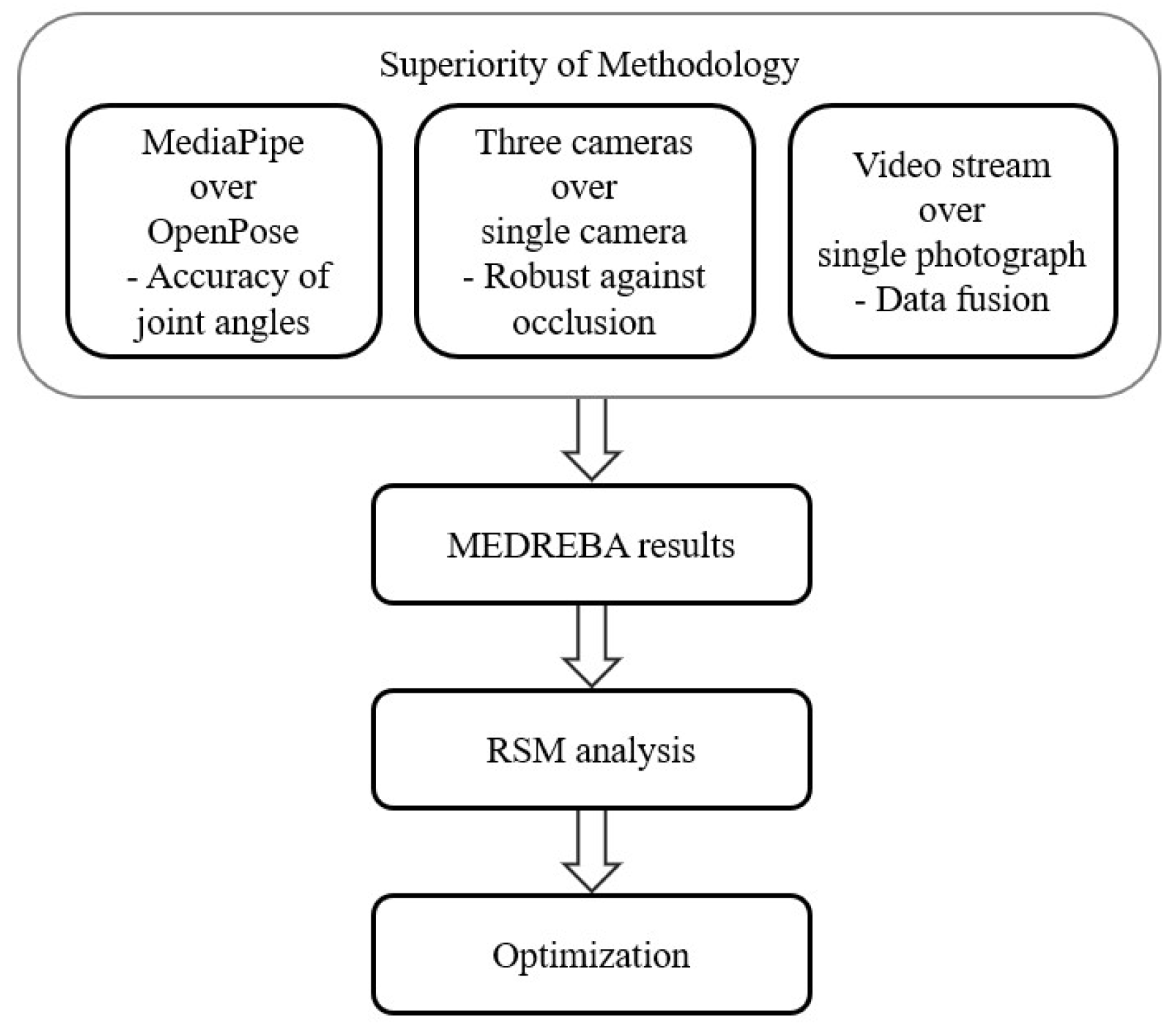
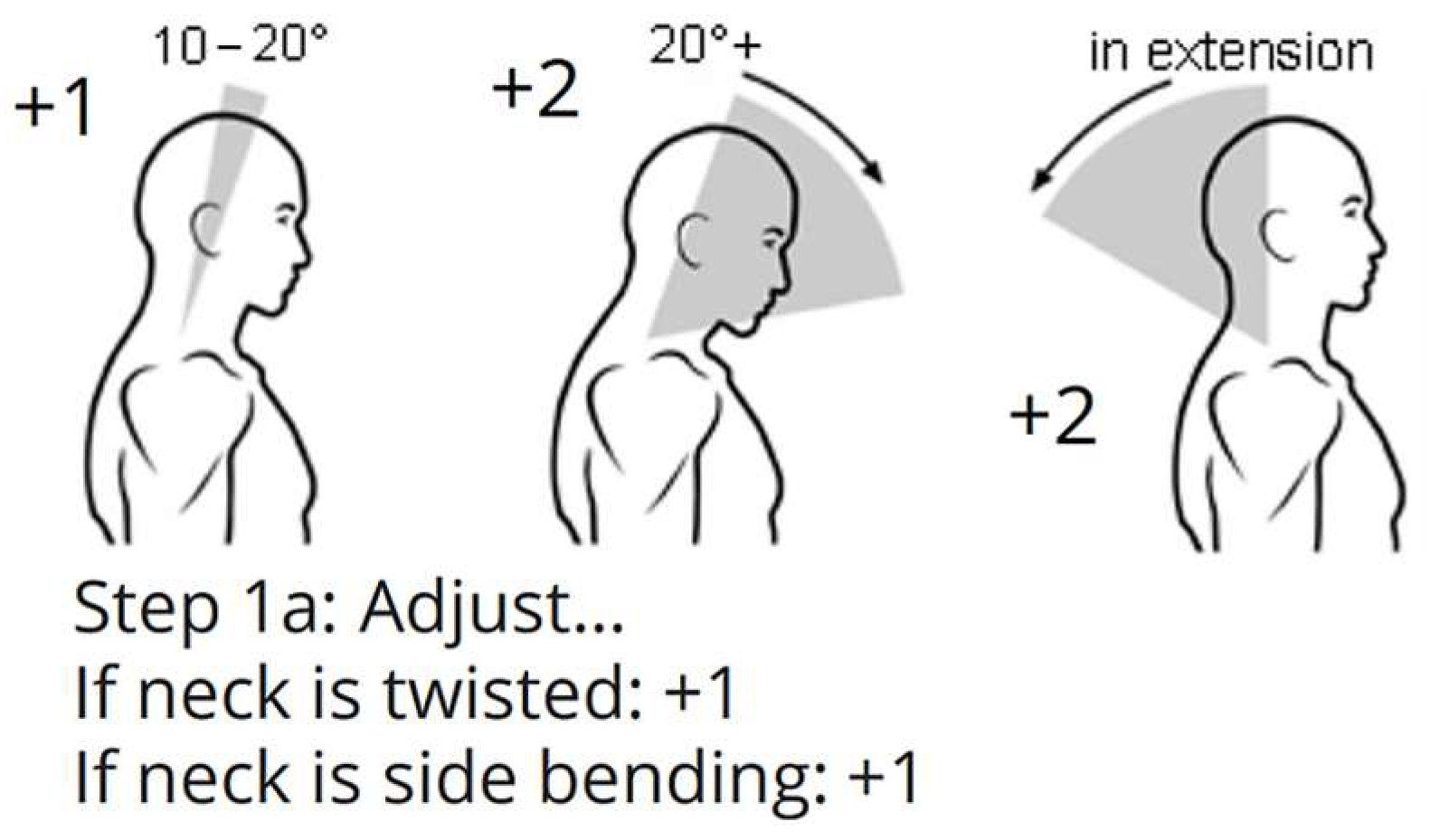
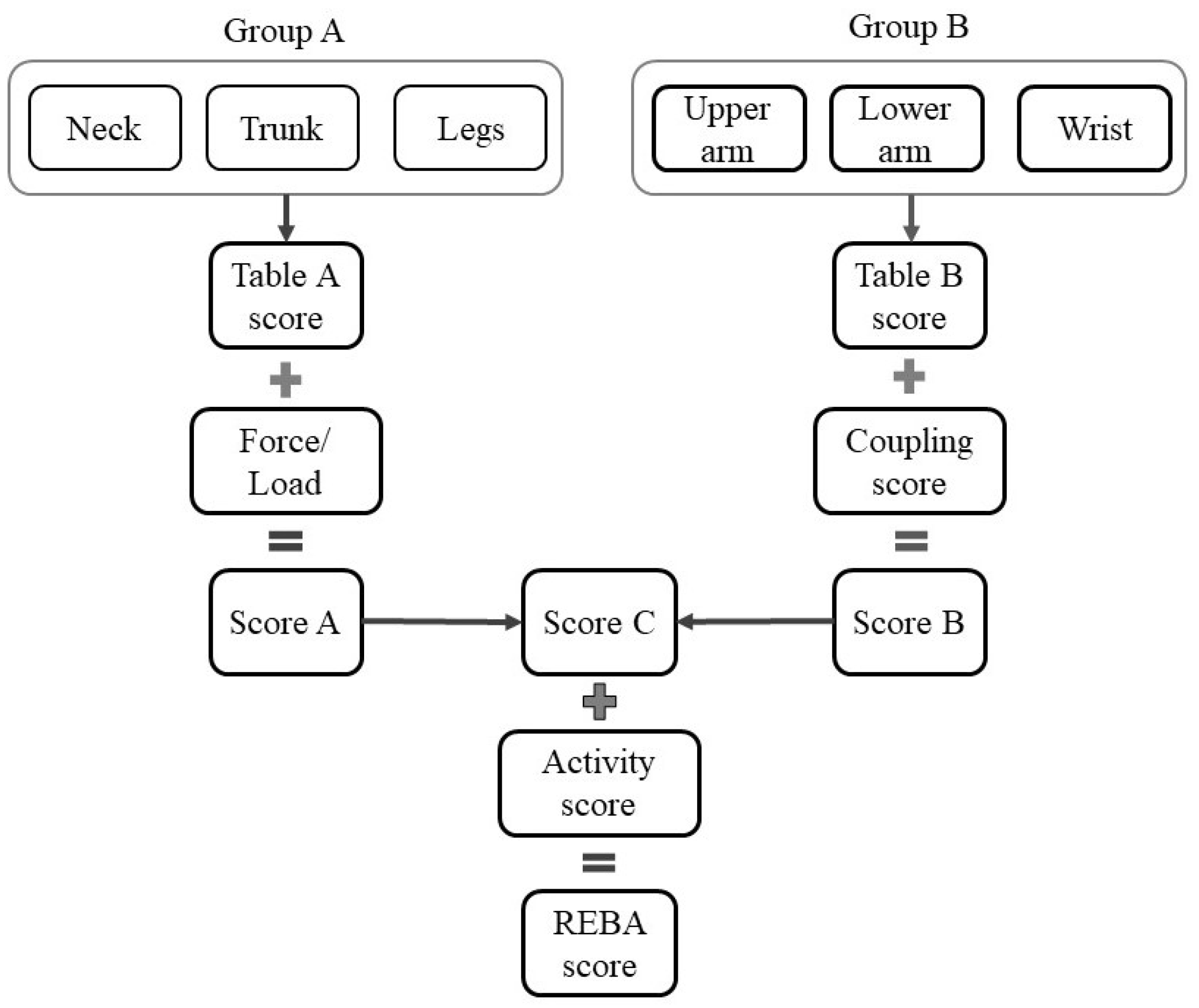
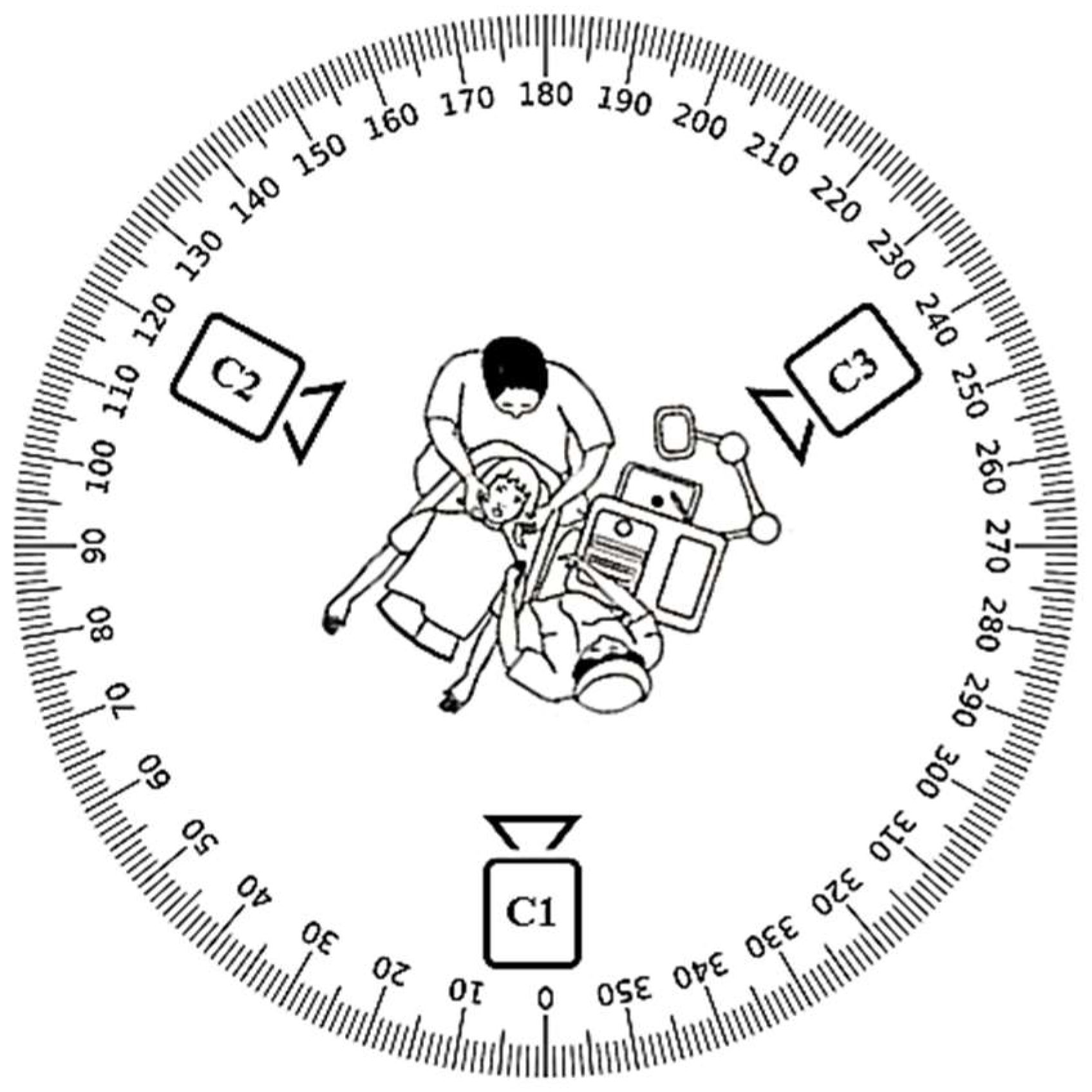
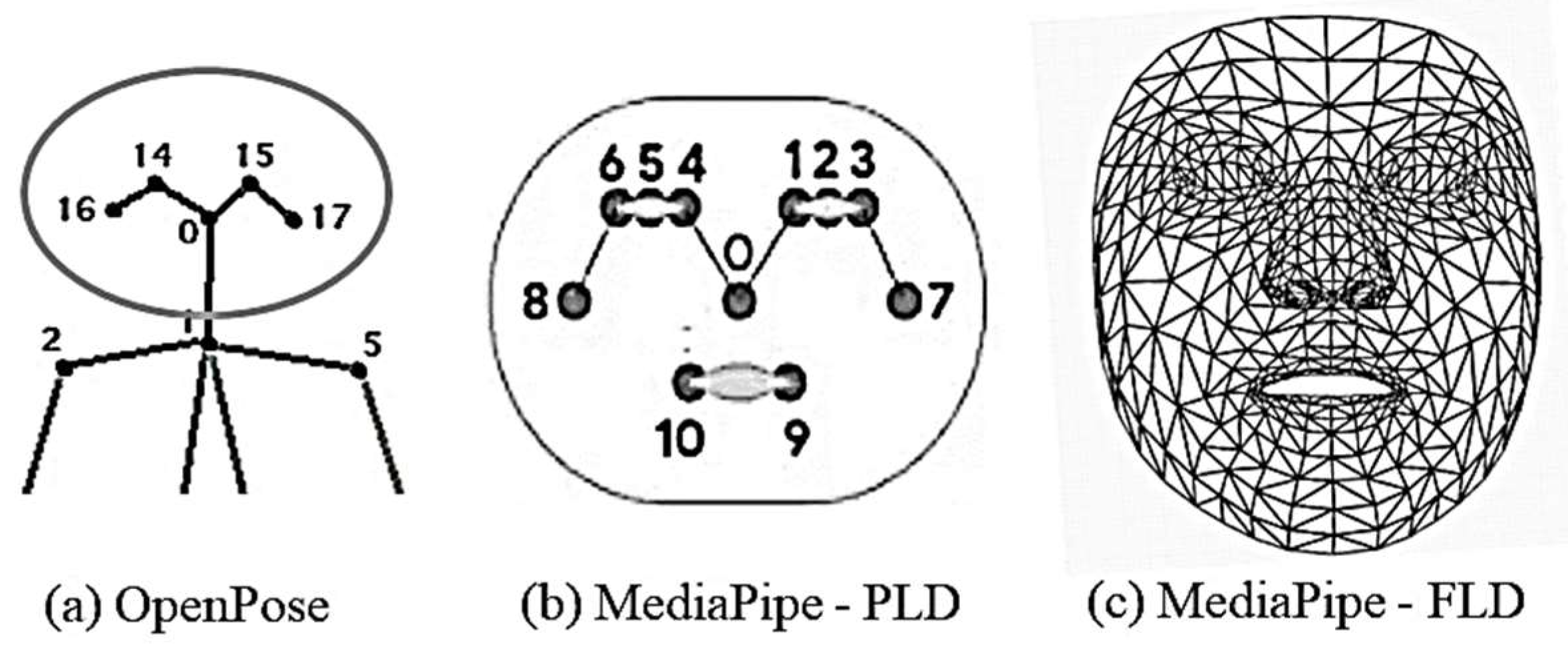

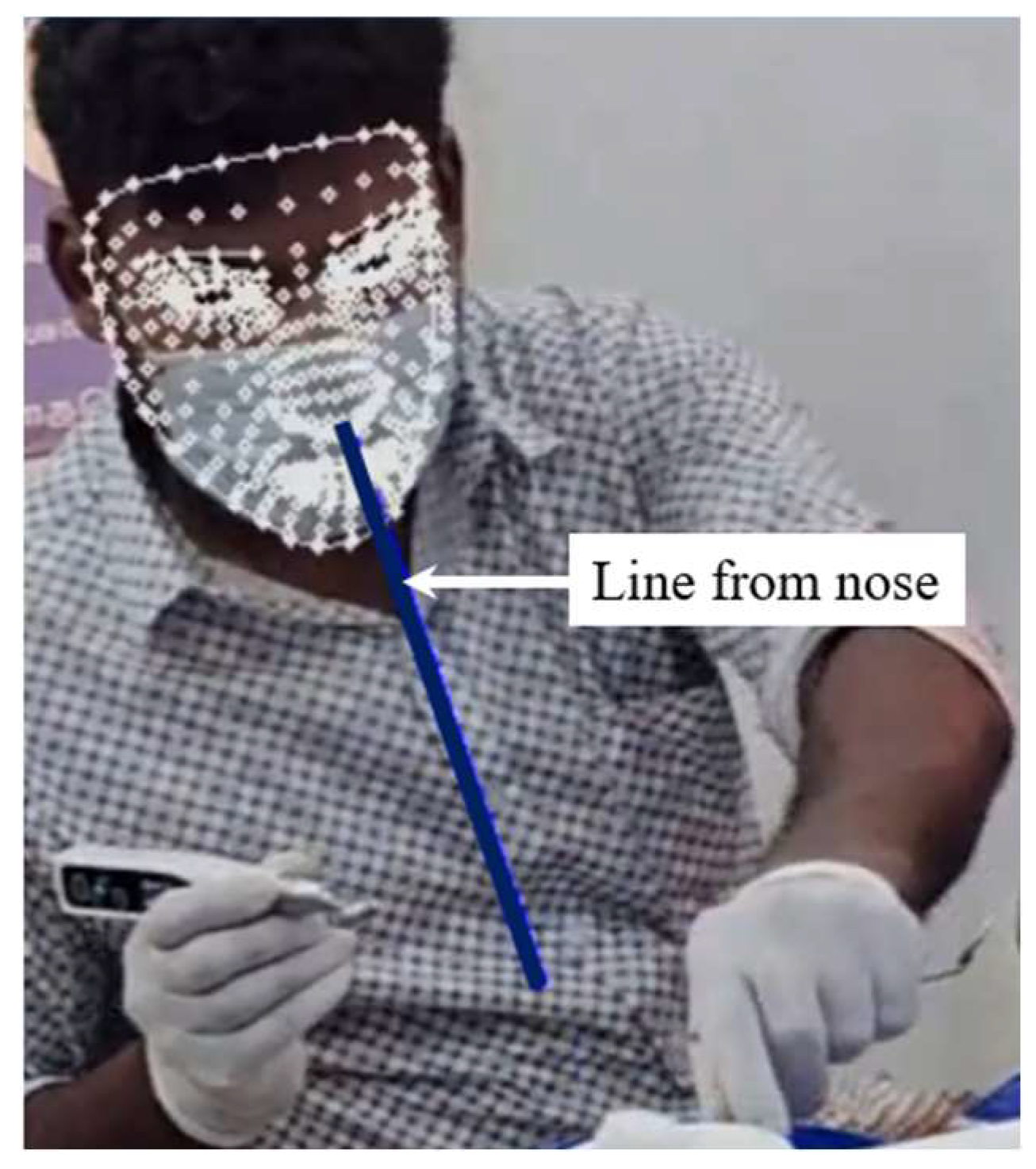
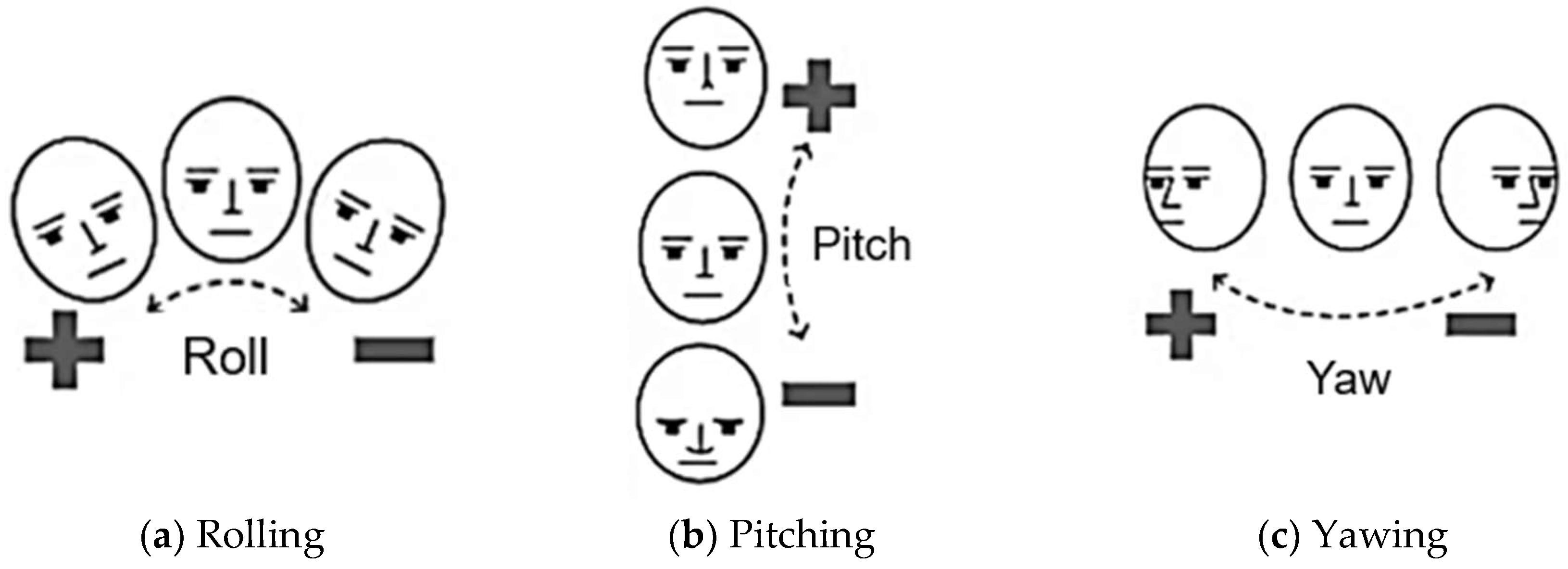
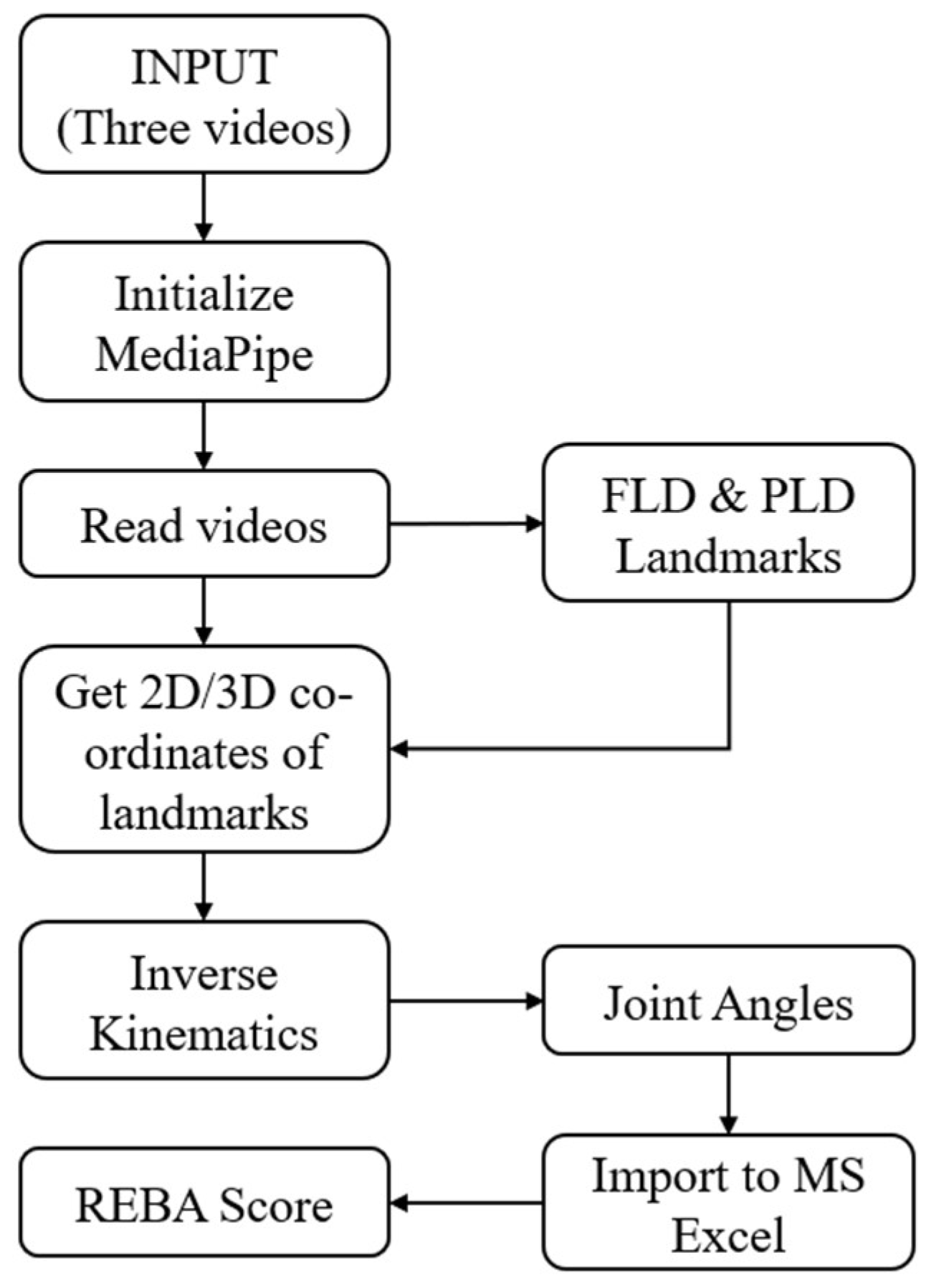
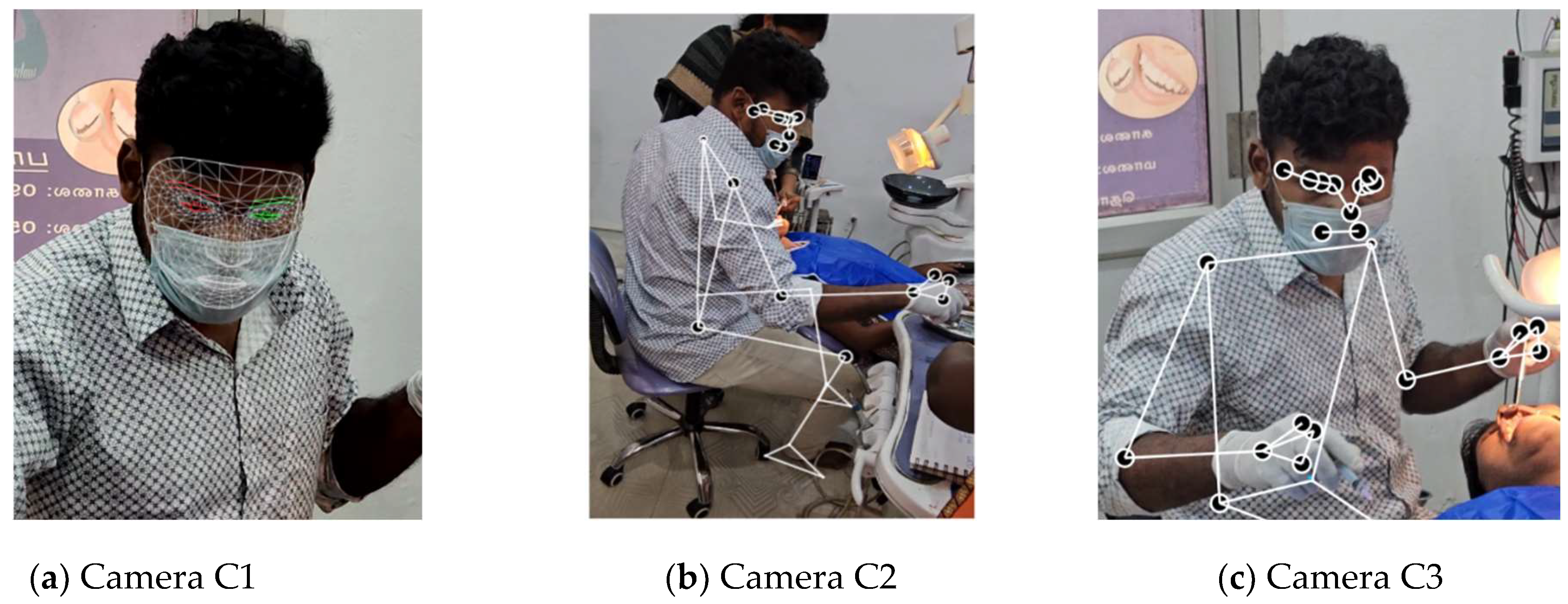

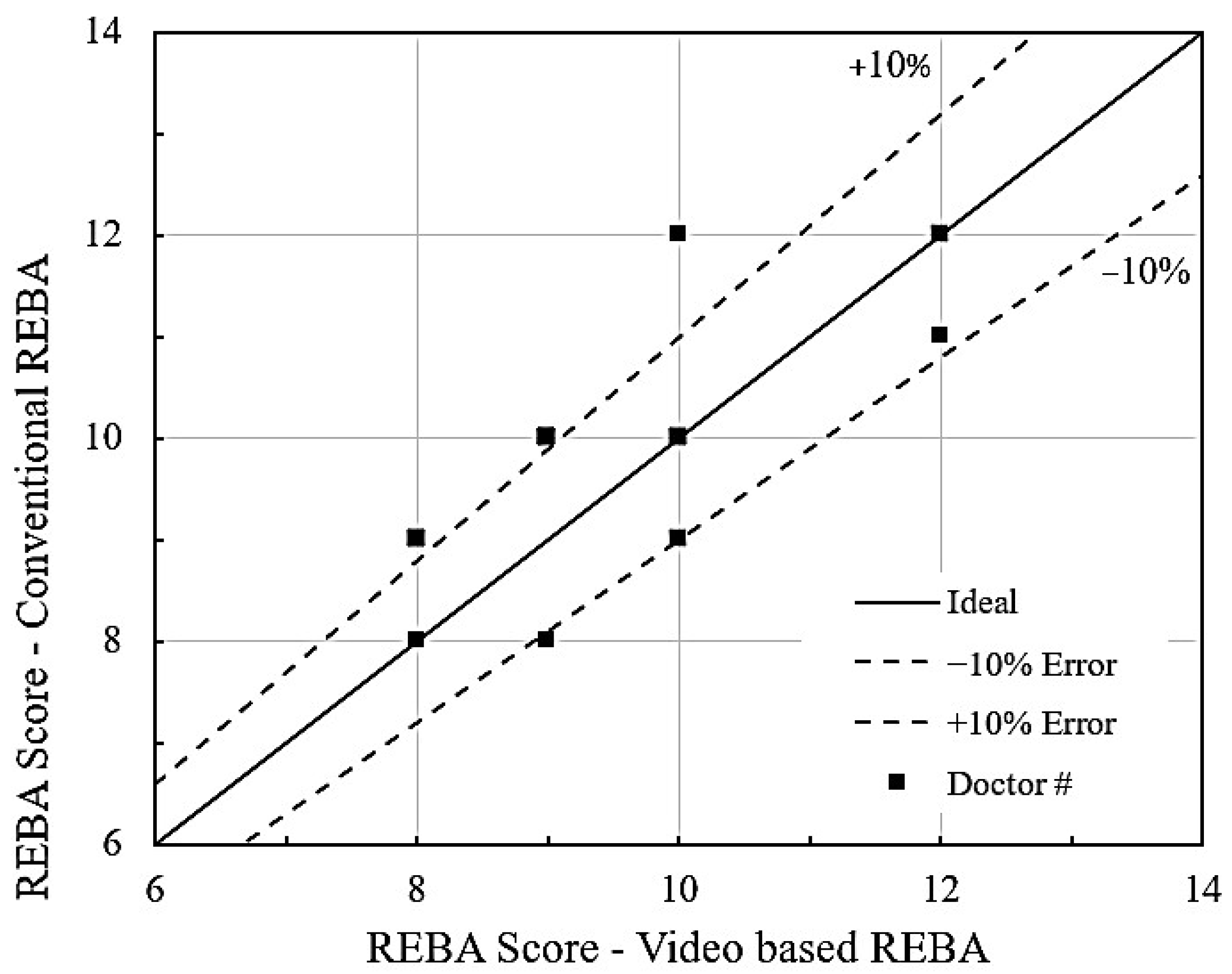

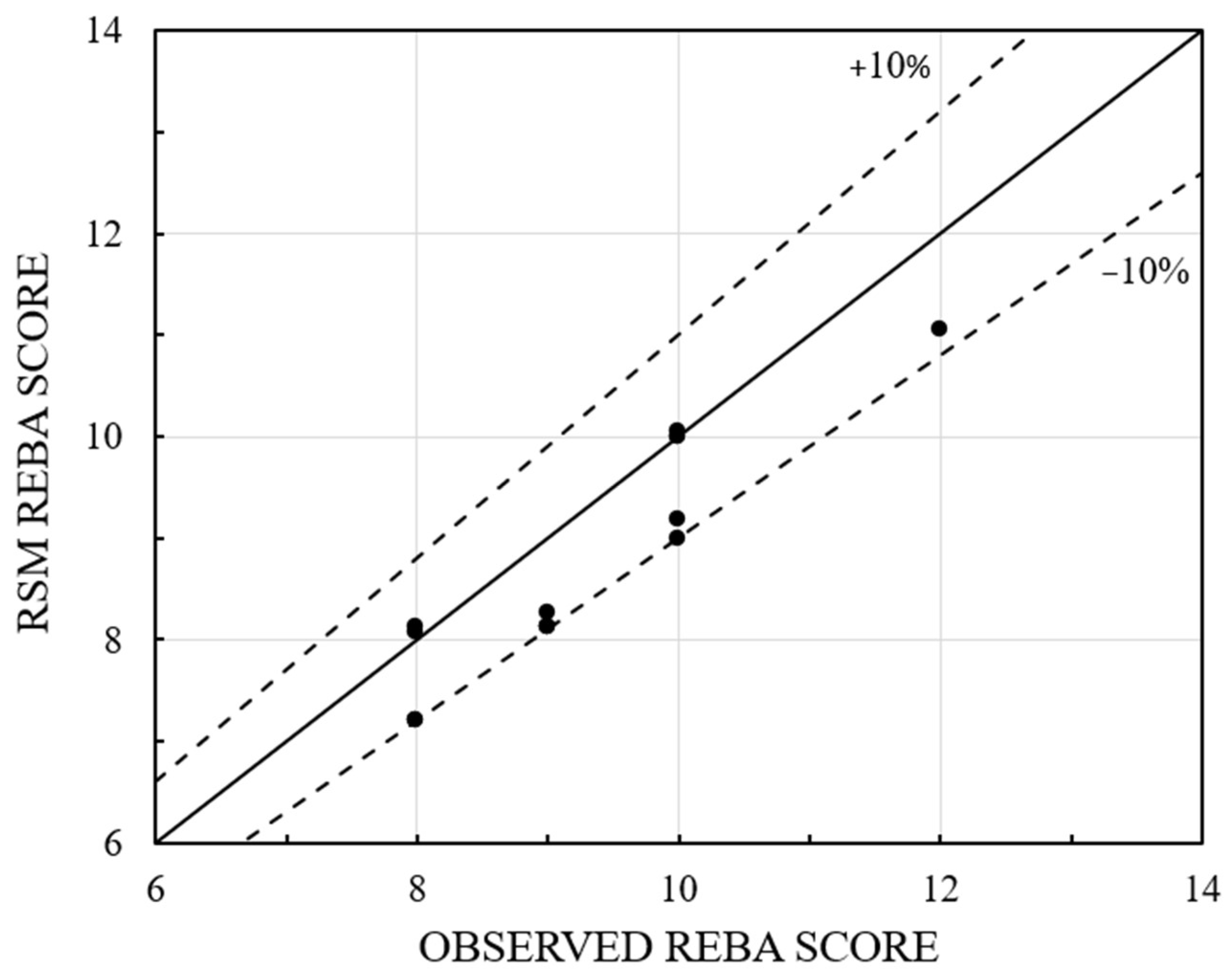
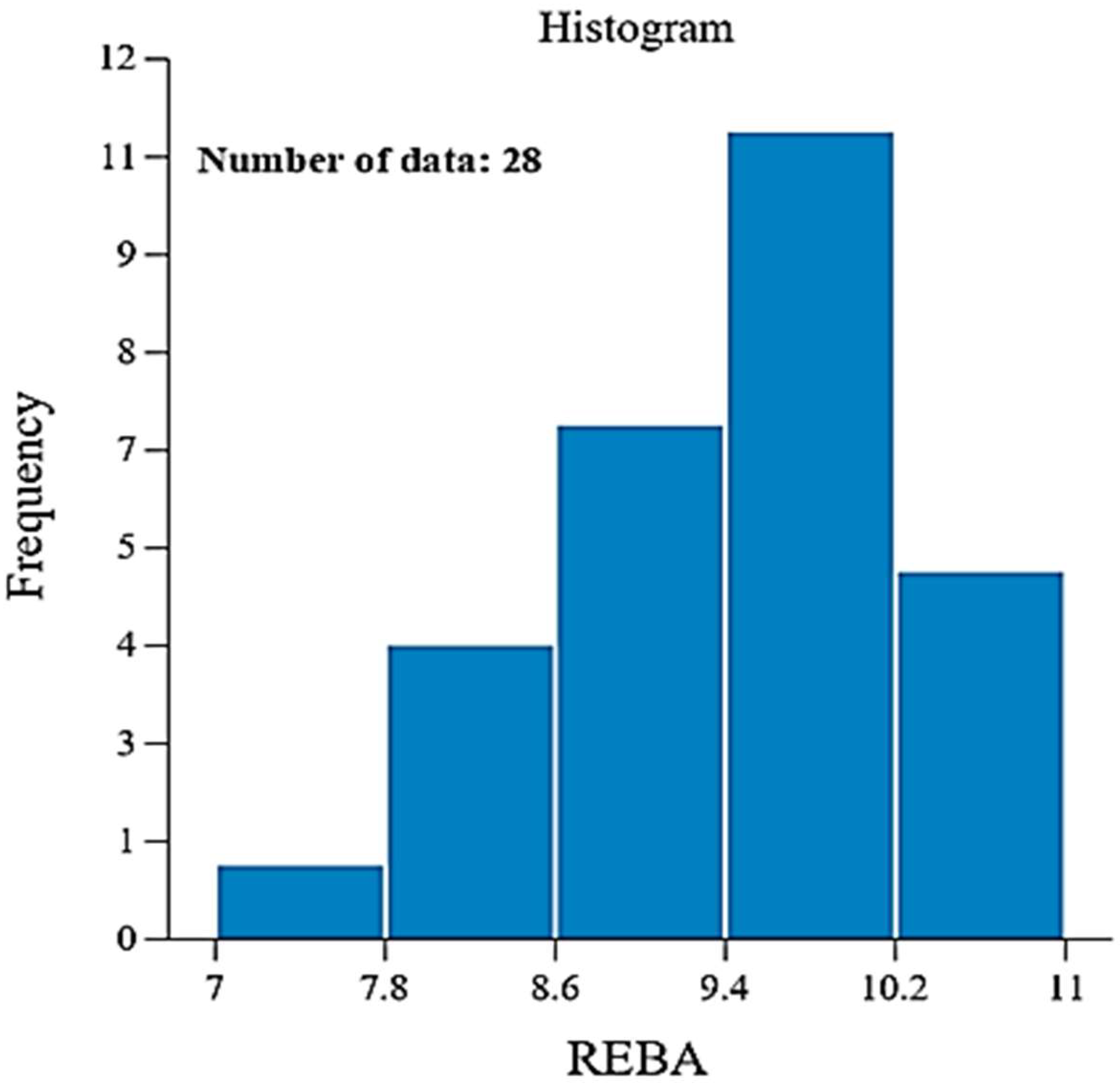
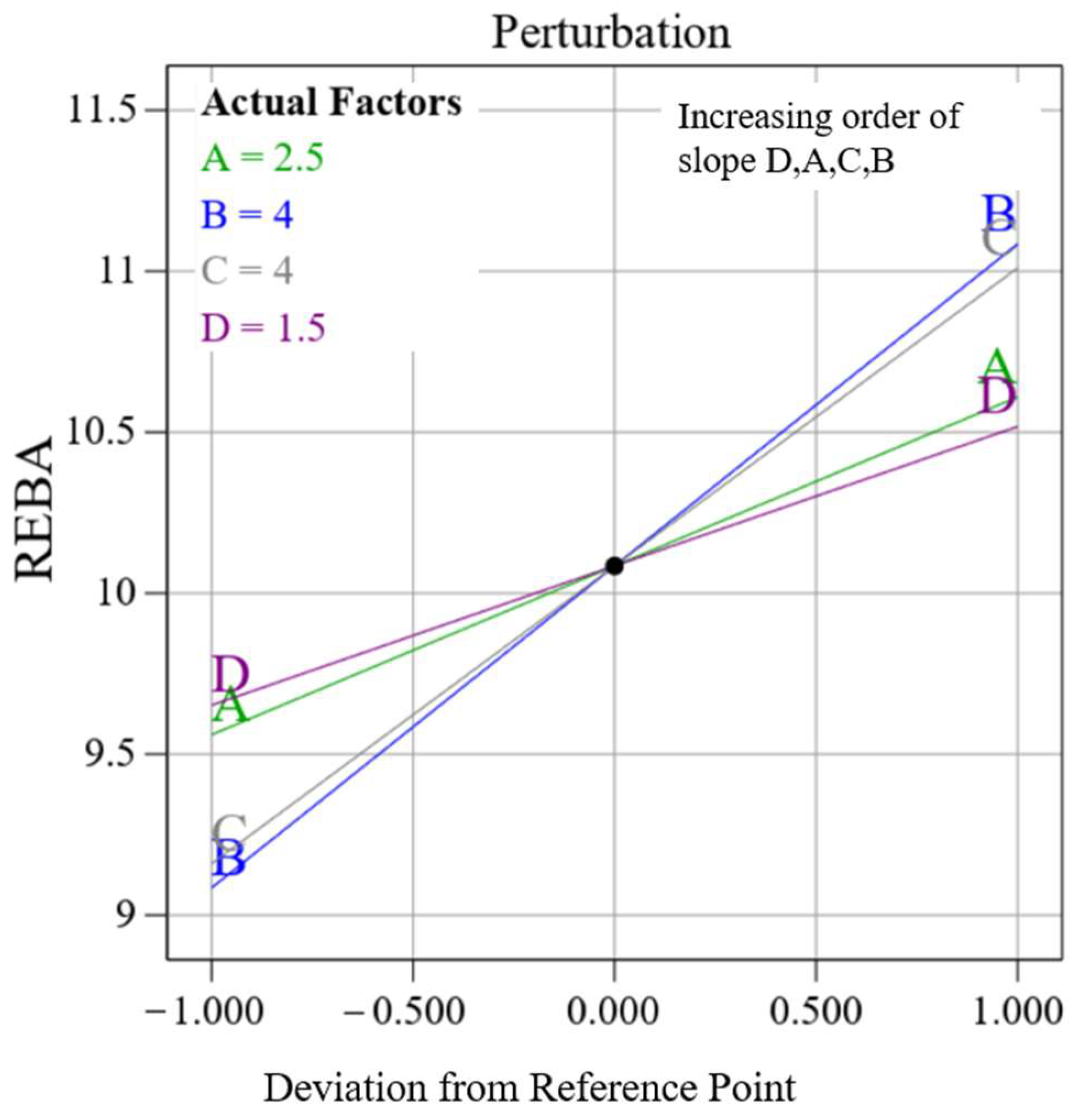

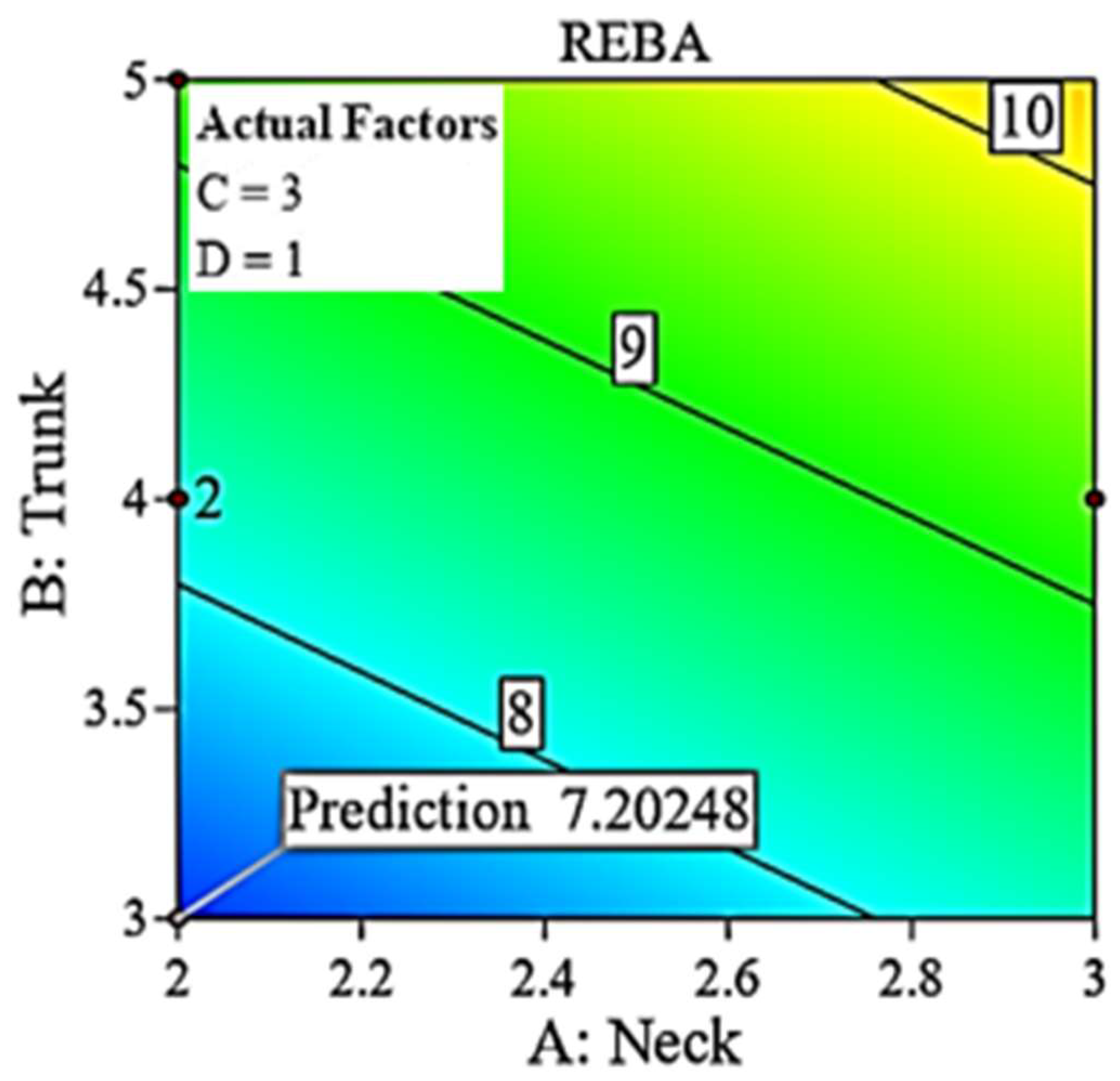
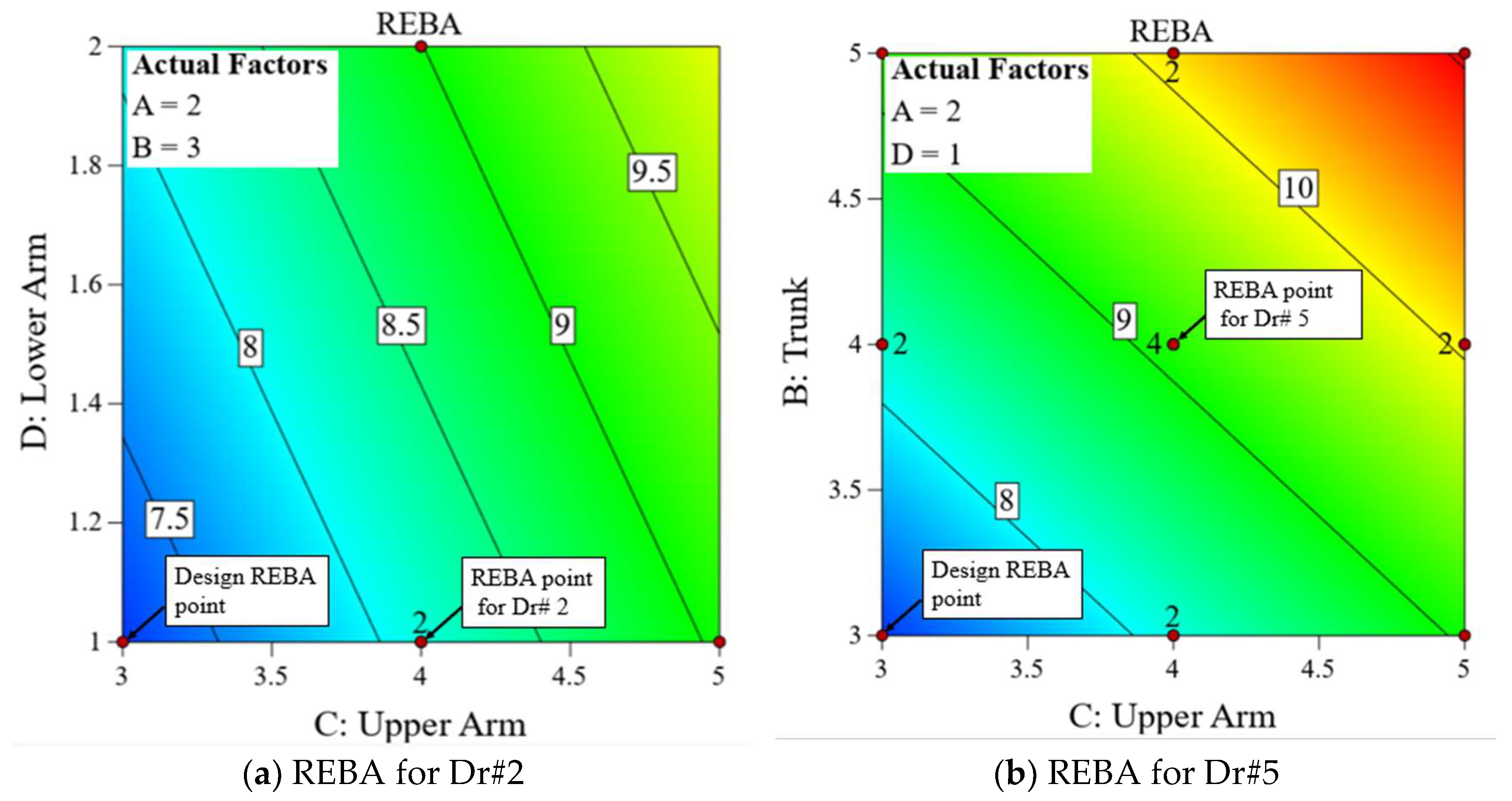

| Subject Characteristics | Values |
|---|---|
| Age (range) | 25–48 Years |
| Height (range) | 151–192 cm |
| Weight (range) | 50–86 kg |
| Gender | All male dentists |
| Experience | 0.5–22 years |
| Working hours | 7 + 2 h/day |
| Working position | Sitting, except 4 |
| Service | Prosthodontics |
| Camera # | Neck | Trunk | Leg | Upper Arm | Lower Arm | Wrist | REBA |
|---|---|---|---|---|---|---|---|
| C1 | 3 | 0 | 0 | 2 | 2 | 3 | |
| C2 | 1 | 1 | 1 | 1 | 1 | 1 | |
| C3 | 3 | 3 | 1 | 3 | 2 | 3 | |
| Resultant (Maximum) | 3 | 3 | 1 | 3 | 2 | 3 | 9 |
| Frame # | Neck | Trunks | Leg | Upper Arm | Lower Arm | Wrist | REBA [22] |
|---|---|---|---|---|---|---|---|
| 1 | 2 | 2 | 1 | 3 | 2 | 1 | |
| 2 | 2 | 2 | 1 | 5 | 2 | 2 | |
| 3 | 1 | 2 | 1 | 2 | 2 | 1 | |
| 4 | 2 | 2 | 1 | 4 | 2 | 1 | |
| 5 | 3 | 2 | 1 | 1 | 2 | 1 | |
| 6 | 3 | 2 | 1 | 3 | 2 | 2 | |
| Average | 2 | 2 | 1 | 3 | 2 | 1 | 8 |
| Frame # | Neck | Trunks | Leg | Upper Arm | Lower Arm | Wrist | REBA [22] |
|---|---|---|---|---|---|---|---|
| 1 | 0 | 2 | 1 | 0 | 2 | 0 | |
| 2 | 0 | 0 | 1 | 5 | 2 | 2 | |
| 3 | 1 | 2 | 1 | 0 | 0 | 0 | |
| 4 | 2 | 2 | 1 | 3 | 2 | 0 | |
| 5 | 0 | 2 | 1 | 1 | 2 | 1 | |
| 6 | 3 | 2 | 1 | 3 | 2 | 1 | |
| Average | 1 | 2 | 1 | 2 | 2 | 1 | 6 |
| Doctor/Max. REBA Points | Neck (3) | Trunk (5) | Legs (4) | Upper Arm (6) | Lower Arm (2) | Wrist (3) | REBA (15) |
|---|---|---|---|---|---|---|---|
| 1 | 2 | 4 | 1 | 4 | 1 | 2 | 9 |
| 2 | 2 | 3 | 1 | 4 | 1 | 2 | 8 |
| 3 | 3 | 3 | 1 | 5 | 1 | 2 | 10 |
| 4 | 2 | 5 | 1 | 6 | 1 | 2 | 12 |
| 5 | 2 | 4 | 1 | 4 | 1 | 2 | 9 |
| 6 | 2 | 3 | 1 | 5 | 2 | 2 | 10 |
| 7 | 2 | 3 | 1 | 4 | 1 | 2 | 8 |
| 8 | 2 | 4 | 1 | 4 | 1 | 2 | 9 |
| 9 | 2 | 4 | 1 | 4 | 2 | 2 | 10 |
| 10 | 3 | 3 | 1 | 4 | 1 | 2 | 9 |
| 11 | 3 | 3 | 1 | 4 | 2 | 2 | 10 |
| 12 | 2 | 3 | 1 | 3 | 2 | 2 | 8 |
| 13 | 3 | 4 | 3 | 5 | 1 | 2 | 12 |
| 14 | 2 | 3 | 2 | 3 | 2 | 2 | 9 |
| 15 | 2 | 3 | 1 | 4 | 1 | 2 | 8 |
| 16 | 3 | 4 | 3 | 4 | 1 | 2 | 12 |
| 17 | 2 | 4 | 1 | 4 | 2 | 2 | 10 |
| 18 | 3 | 3 | 2 | 3 | 1 | 2 | 10 |
| Source | Sequential p-Value | Adjusted R2 | Predicted R2 | |
|---|---|---|---|---|
| Linear | <0.0001 | 0.9055 | 0.8653 | Suggested |
| 2FI | 0.0010 | 0.9615 | Suggested | |
| Quadratic | 0.0041 | 0.9791 | Aliased |
| Source | F-Value | p-Value | |
|---|---|---|---|
| Model | 65.66 | <0.0001 | significant |
| A (Neck) | 46.83 | <0.0001 | significant |
| B (Trunk) | 110.70 | <0.0001 | significant |
| C (Upper Arm) | 85.49 | <0.0001 | significant |
| D (Lower Arm) | 35.88 | <0.0001 | significant |
| Maximization | Minimization | |||
|---|---|---|---|---|
| RSM | Verification | RSM | Verification | |
| Neck | 2.98 | 3 | 2 | 2 |
| Trunk | 4.90 | 5 | 3 | 3 |
| Upper arm | 4.05 | 4 | 3 | 3 |
| Lower arm | 1.0 | 1 | 1 | 1 |
| REBA | 11.11 | 11 | 7.2 | 7 |
| Desirability | 1.0 | - | 0.95 | - |
Disclaimer/Publisher’s Note: The statements, opinions and data contained in all publications are solely those of the individual author(s) and contributor(s) and not of MDPI and/or the editor(s). MDPI and/or the editor(s) disclaim responsibility for any injury to people or property resulting from any ideas, methods, instructions or products referred to in the content. |
© 2025 by the authors. Licensee MDPI, Basel, Switzerland. This article is an open access article distributed under the terms and conditions of the Creative Commons Attribution (CC BY) license (https://creativecommons.org/licenses/by/4.0/).
Share and Cite
Manohar, B.A.; Devaraj, J.; Maheswaran, C.; Pugalenthi, S. Performance Evaluation of Rapid Entire Body Assessment Using AI-Assisted Ergonomic Analysis in Dentistry. Biomimetics 2025, 10, 239. https://doi.org/10.3390/biomimetics10040239
Manohar BA, Devaraj J, Maheswaran C, Pugalenthi S. Performance Evaluation of Rapid Entire Body Assessment Using AI-Assisted Ergonomic Analysis in Dentistry. Biomimetics. 2025; 10(4):239. https://doi.org/10.3390/biomimetics10040239
Chicago/Turabian StyleManohar, Benhar Arvind, Jebakani Devaraj, Chellapandian Maheswaran, and Selvan Pugalenthi. 2025. "Performance Evaluation of Rapid Entire Body Assessment Using AI-Assisted Ergonomic Analysis in Dentistry" Biomimetics 10, no. 4: 239. https://doi.org/10.3390/biomimetics10040239
APA StyleManohar, B. A., Devaraj, J., Maheswaran, C., & Pugalenthi, S. (2025). Performance Evaluation of Rapid Entire Body Assessment Using AI-Assisted Ergonomic Analysis in Dentistry. Biomimetics, 10(4), 239. https://doi.org/10.3390/biomimetics10040239







